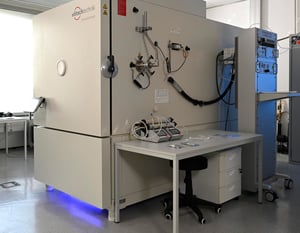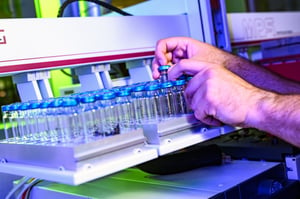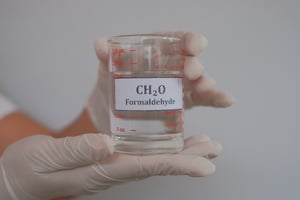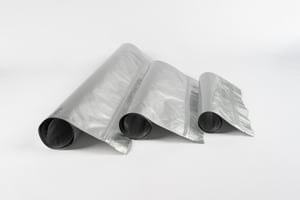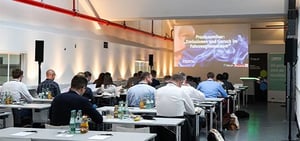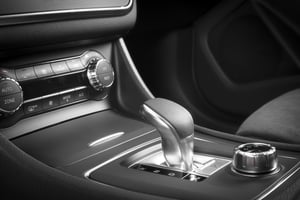
Fogging
Determination of the fogging behavior of materials used in vehicle interiors
FOGGING TEST IN THE
AUTOMOBILE INTERIOR
PRECISE TESTING FOR OPTICAL QUALITY
Color and gloss measurements are essential test methods in the automotive industry for objectively evaluating surfaces. These tests support suppliers and manufacturers in meeting the requirements of car manufacturers and documenting consistent quality.
- Gloss measurement
- Color measurement
- Areas of application
Objective evaluation of light reflection
Gloss describes how strongly a surface reflects light. Gloss measurement makes it possible to objectively determine this degree of reflection by shining a light beam onto the surface at a defined angle (e.g. 20°, 60° or 85°) and measuring the reflected light.
Areas of application for gloss measurement
- Testing the optical properties of coatings and paints.
- Testing plastic and metal components indoors and outdoors.
- Documentation of the results for evaluating production and supplier quality.
Gloss measurement provides standardized results that are independent of subjective perceptions.
Accuracy at the highest level
Objective color measurement is indispensable in the automotive industry, as the human eye is often unable to reliably detect the finest color differences. Colorimetric methods (colorimetry) record the color effect of a sample using numerical values, independent of the subjective color impression.
Areas of application for colorimetry
- Testing of painted components such as bumpers or trim strips.
- Analysis of plastics, textiles and leather in vehicle interiors.
- Documentation of color deviations after environmental simulation tests such as UV and aging tests.
Color measurements enable a precise assessment of chromaticity (color effect) and ensure that color deviations remain within specified tolerances.
Typical areas of application
Our tests are used for a wide range of materials and components:
- Painted surfaces: Body parts, bumpers, mirror caps.
- Plastics: door panels, center consoles, dashboards.
- Textiles and leather: interior trim, seat covers.
- Coated metals: trim strips, exterior mirrors.

Test methods
- DIN EN ISO 11664-4 (CIE 1976)
- VW 50190 (Color)
- VW 50190 (Gloss)
- DIN EN ISO 2813
- Ford FLTM BI 110-01
- DIN 67530
- BMW AA-0101 / DIN EN ISO 2813
- and much more.
Fogging test methods
- DIN 75201-A (reflectrometric)
- DIN 75201-B (gravimetric)
- PV 3015 (Volkswagen)
- GMW 3235-A (General Motors Worldwide)
- PSA D45 1727
- and much more.
Are you looking for an exam? Standard? Specifications?
Accredited & certified tests
CONTACT OUR EXPERTS
Description. Lorem ipsum dolor sit amet, consetetur sadipscing elitr, sed diam nonumy eirmod tempor invidunt ut labore et
- Tab Title






Frequently asked questions about the fogging test
The sample quantities required for a fogging test depend on the standard and the test method used. Here are the general guidelines:
1. standard DIN 75201 (type A and type B)
-
Type A (glass plate method):
A sample quantity of 10 cm² is typically required. The sample is placed on a heated plate in a sealed chamber and the volatiles released condense on a glass plate above. -
Type B (aluminum foil method):
Similar to type A, a sample volume of approximately 10 cm² is used. However, the volatile substances condense on a cooled aluminum foil.
2. standard ISO 6452 (international standard)
- Sample quantity:
Again, a sample size of about 10 cm² is typically required to evaluate the amount of volatiles released at elevated temperature.
3. other specific requirements
Depending on the specific requirements of the customer or OEM standards, sample quantities may vary. It is important to check the respective standards or test requirements carefully.
Method A - Reflectometric method:
- Principle: This method measures the change in reflectivity on a glass plate on which volatile components from the material sample are deposited.
- Procedure: A material sample is heated in a beaker while a glass plate above it is cooled to 21°C. The temperature difference causes the volatile components to condense on the glass plate. The reflectance index of the fogged glass plate is then measured to determine the amount of condensed material.
- Application: This method is particularly suitable for materials for which an exact determination of the optical fog effect is required.
Method B - Gravimetric method:
- Principle: This method measures the weight of condensed volatiles on an aluminum foil.
- Procedure: The material sample is heated in a beaker while an aluminum foil disc is cooled to 21°C. After 16 hours, the amount of condensed material on the foil is weighed.
- Application: This method is ideal for an accurate quantitative determination of the amount of condensed volatiles.
SURFACE TESTS
Medienbeständigkeit in der Automobilbranche
Read moreWebinar Insights: Grundlagen der Dickenmessung bei Textilien
Read moreOptimierung der Automobilsitze: Nahtqualität im Fokus
Read moreMace Snag Prüfung: Qualitätssicherung bei Automobiltextilien
Read moreWie Automobilzulieferer die richtigen Prüfnormen finden
Read moreWas versteht man unter Umweltsimulation im automobilen Kontext?
Read moreFREQUENTLY ASKED QUESTIONS ABOUT MECHANICAL TESTING
Gloss measurement provides objective results on the reflection of light on surfaces and helps to ensure the consistency and quality of painted and coated materials.
When measuring color, color differences are analyzed using numerical values in order to document color deviations between different components or after load tests.
Yes, imat-uve is accredited, released and approved for various tests.
Disclaimer
The information provided is based on many years of experience and is for general information purposes only. No guarantee is given for the correctness, completeness or topicality of the contents. Warranty claims cannot be derived from this information and the rights of third parties remain unaffected. Details on sampling, sample preparation, test equipment, test methods and the performance and evaluation of test results can be found in the current versions of the underlying standards.


